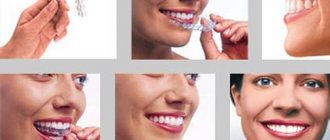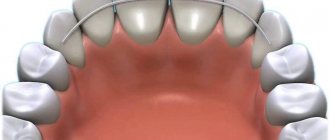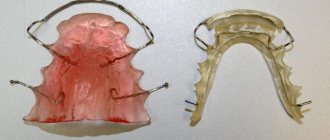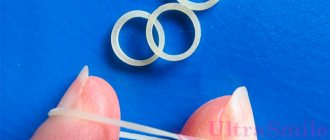Publication date: June 01, 2022.
Date the information on this page was updated: January 21, 2022.
Orthodontic treatment does not end with the removal of braces, because immediately after removal, the bone tissue and ligaments will begin to return to their original position and move the teeth. To consolidate the result after removing braces, it is necessary to install retention structures that will hold the teeth in the correct position until the bone tissue is finally formed around the roots of the teeth.
- What are retainers?
- Fixed retainers
- Removable retainers and mouthguards
- Combined
- How do retainers work?
- How long should retainers be worn?
- The process of installing permanent retainers
- How to care for retainers?
- Which is better: mouthguards or retainers?
- Frequently asked questions about retainers
- What problems can arise with a retainer?
- Reviews about retainers
Fixed retainers
A permanent retainer is a wire arch made of medical steel, which is attached to the inside of the teeth with a special compound. This type of retainer is used most often, as they are completely invisible, cannot be felt in the mouth and do not oxidize. Fixed retainers can come off due to mechanical stress, such as chewing hard food. In this case, you should immediately visit the orthodontist and return the retainer to its place to prevent the teeth from moving.
Fixed retainers have many advantages: you can’t forget to put them on - they are always on your teeth, and they are absolutely invisible and do not interfere. The main feature of wearing a fixed structure is the need for careful home hygiene and professional cleaning every six months at the dentist, since plaque in hard-to-reach places around the retainer is more difficult to clean.
Is it possible to remove the structure yourself?
As for such dental retainers, which are removable, everything is simple - they can be removed from the mouth independently. But in no case should you do this with non-removable ones, because... this can cause damage not only to the structure itself, but also to the enamel of your teeth. Such systems should only be crushed by the orthodontist who fixed them. How does this process happen? At the appointment, a specialist carefully cuts off the wire with a special tool and peels off the intermediate elements of the system (usually, they are carefully cut off with a bur). Next, the specialist cleans your enamel, applies a composite material to close the grooves and polishes the surface of the teeth.
The structure can only be removed by a specialist
Removable retainers and mouthguards
Removable retention structures come in two types:
- Plastic plates with a metal arch that encircles the dentition;
- Transparent mouth guards made of silicone.
After braces are removed, mouthguards or plates must be worn constantly, removed only during meals, brushing teeth, or public speaking. In the future, on the recommendation of a doctor, the time of wearing retention structures is reduced: they are removed at night and worn less during the day. Removable structures can be noticeable to others, and at first they affect diction and cause increased salivation. Typically, removable retainers are prescribed at the end of the retention period after fixed structures, but they can also be used independently throughout the entire retention period.
Plastic plates with metal arc
Silicone transparent mouth guard
Conclusions. Expert advice
The retention period is a very important part of correcting dental pathologies. If the patient behaves incorrectly at this time, the effect may well come to naught. The problem can be prevented using special removable or non-removable devices. They are called retainers.
Main features of orthodontic appliances:
- Requires regular wear for several years.
- They can be removed or attached to the teeth for life - it depends on the patient and the characteristics of his body.
- They require special attention to oral hygiene, the use of an irrigator and brushes.
- They must be worn under the supervision of a specialist.
Doctors know that it is the dental retainer that keeps the bite in the correct state until the muscles get used to the new position of the molars, incisors and canines. It is mandatory to wear the device. If problems arise with any type of orthodontic design, you can always choose another option that will better suit the patient.
How do retainers work?
Braces or aligners actively move teeth in the desired direction due to the traction of the arch and pressure on the dentition. A non-removable wire retainer does not put pressure on the teeth, but only holds them in the desired position, preventing them from moving apart. Removable aligners differ from aligners in that they are not used with attachments (activators of tooth movement), but exactly repeat the shape of the dentition and fit tightly to the teeth, fixing the dentition. Any retention structure does not move the teeth, but at the same time it should prevent the ligaments from relaxing and returning to their previous position until the bone tissue around is completely strengthened.
Why are these structures installed?
Braces move teeth in the desired direction, but this effect is not limited to simple correction. This procedure is accompanied by the reconstruction of blood vessels and ligaments.
In the area where the tooth moves, bone tissue is absorbed, and in the opposite area, the process of its formation takes place.
And if muscles quickly adapt and change the principle of their work, then bone formation takes a long time . Therefore, the level of tooth mobility is maintained and auxiliary fixation is required until a layer of new tissue forms.
Retainers are installed to keep teeth from moving as the body gets used to the unusual position. This requires a lot of effort, therefore, the fastening device must be as rigid as possible.
Refusal to use special devices leads to the fact that nature takes its course, and the teeth quickly return to their original places. Thus, the result of long-term treatment is reduced to zero.
For this reason, doctors recommend installing retainers after adjusting the dentition with braces.
How long should retainers be worn?
The duration of the retention period is on average 2 times longer than wearing braces, and patients who corrected their bite in adulthood - after 25-30 years, can wear retainers all their lives.
The length of time you wear retainers usually varies from person to person and depends on the following factors:
- Age of the orthodontic patient. The younger a person is, the faster his ligaments and muscles are rebuilt, thereby fixing the teeth and bite in the correct position. For patients who received braces as teenagers, wearing retainers for 6 months to 2 years is sometimes sufficient.
- Bad habits. People who smoke have poor blood supply and reduced immunity, so all processes of restructuring the position of teeth and healing are slower than in non-smokers.
- Oral health. If the teeth and periodontal tissues are healthy, the fixation of the ligamentous apparatus occurs faster.
- Complexity of the clinical case. The stronger the initial curvature of the teeth, the longer you need to wear a retainer.
The retention period must be carried out under the supervision of an orthodontist so that he monitors the condition of the bite. In any case, you should not stop wearing retainers without your doctor's approval, otherwise your teeth may become crooked again.
Do you need retainers after removing braces?
The main purpose of retainers is to consolidate the results achieved during the use of braces. The clinical effect of retainers can be explained by the implementation of the following mechanisms:
Preventing the possibility of teeth returning to their original position after successful correction of bite errors. This kind of effect is explained by the so-called “muscle memory”, because the changes that result from wearing braces for a long time affect the muscles and joints.
Fixing the bite in a constant position is achieved by influencing the ligaments - the most pliable part of the row of teeth. Even the ideal correction of malocclusions is eliminated in the absence of retainers - a factor that strengthens from the inside.
It is a common case that after braces, a retainer is not installed for the required period, or is not installed at all. Then you have to start all the treatment again.
These designs have a number of advantages:
- Fixation of the position of the teeth, which they occupied due to long-term wearing of braces.
- Keeping teeth in the required position.
- Possibility of creation taking into account individual requirements.
- Relative aesthetics. Installed retainer braces will not be noticed by anyone except the patient.
The use of retainers in combination with mouth guards is justified. The combination of the proposed splinting method with plastic mouthguards, which must be worn at night, proves the most effective.
The process of installing permanent retainers
Retainers are installed after braces are removed on completely healthy teeth after professional hygiene. The patient may need to undergo oral sanitation after orthodontic treatment. While wearing braces, it is difficult to clean your teeth perfectly, and accumulated plaque can cause caries and tartar. Retainers cannot be installed on affected teeth, since another design in the mouth will again complicate hygiene and lead to a deterioration in the condition of the oral cavity. Also, during orthodontic treatment, the enamel may become thinner, so in addition to hygienic cleaning, teeth need fluoridation and mineralization.
After carrying out therapeutic and preventive measures, the orthodontist begins the laboratory stage of manufacturing retainers. An impression is taken from healthy teeth, according to which the retainer is given the necessary shape of the dentition.
Before the actual installation of the retainer, the teeth are etched with a special solution so that their surface becomes slightly rougher for better adhesion. In some cases, instead of etching the teeth, the teeth are prepared: a microgroove is drilled on the inside to fix the retainer. Once the teeth are prepared, the retainer is placed in the desired position and secured with composite material. The procedure is completed by grinding the material for the patient’s convenience.
The installation procedure takes 15-20 minutes and is absolutely painless. But in the first days of adaptation, the retainer can rub and reduce the clarity of diction.
Is it possible to remove the wire yourself?
Another popular question regarding the retention period is related to how the wire structure is removed and whether it can be done independently. It is immediately necessary to make a reservation that only a specialist can do this in a clinical setting, and he also determines the duration of wearing the structure, as well as the advisability of replacing it with another type of corrective device. The removal procedure takes 10-15 minutes. First, the doctor carefully cuts the wire using a special tool, and then peels off the fixing elements. The remaining polymer composition is removed from the enamel and the cleaned surface is polished. You cannot remove the fasteners yourself, as this can seriously injure the enamel.
How to care for retainers?
Retainers, like any structure in the mouth, without careful hygiene provoke the accumulation of bacteria, the appearance of plaque and caries.
- You can brush your teeth with a regular toothbrush and toothpaste, but be careful when brushing the inside of your teeth if you have a permanent retainer;
- If the retainer comes unstuck, you need to visit the orthodontist and return it to its place so that an orthodontic relapse does not occur;
- For thorough hygiene when wearing fixed retainers, it is recommended to use a waterpik, brushes and dental floss to clean hard-to-reach places near the arch;
- Removable retainers and mouth guards should be washed with disinfectants, soap, or brushed with toothpaste at least 2 times a day.
- Mouthguards must be removed when eating and smoking and stored in special containers;
- Mouthguards should not be washed with hot water because they will become deformed.
- To strengthen the enamel, it is recommended to rinse the mouth with a fluoride solution.
After braces are removed and retainers are installed, you should periodically visit the orthodontist for follow-up examinations and the hygienist to maintain oral health. Only after the end of the retention period can orthodontic treatment be considered complete.
Oral care and hygiene
Different types of retainers require unique care.
For non-removable devices - special conditions:
- brushing your teeth twice a day with a soft brush to avoid damage and disruption of fixation (toothpicks should not be used);
- use of superfloss (dental floss);
- rinsing the mouth with fluoride to remove food debris;
- checking the integrity of the device, the strength of fixation;
- eating soft foods: this will reduce the load and reduce the risk of damage.
For removable devices, other recommendations:
- the device should be washed with soap and water and placed in a disinfectant solution twice a day;
- Before eating, the device must be removed, otherwise breakdowns and rapid wear may occur;
- drinking drinks with dyes, smoking, lead to a change in the color of the material;
- contact of the structure with hot water is harmful, as deformation is possible;
- Before use, the retainer must be rinsed with water;
- after operation at night, the system should be treated with a solution of chlorhexidine (0.05%), the use of aggressive agents, for example, hydrogen peroxide, is contraindicated;
- cleaning with toothpaste is excluded; powders are recommended for this: for dentures or Retainer Brite;
- bends can cause cracks;
- Purchasing a special case will help keep the device clean.
In addition to the above recommendations, the use of any type of retainers requires constant supervision by a specialist , regular (twice a year) cleaning of stones and plaque.
Ignoring hygiene rules leads to inflammation, bleeding gums, unpleasant odor, and the formation of hard deposits.
Which is better: mouthguards or retainers?
Retention mouthguards and a non-removable retainer after orthodontic treatment are used in combination: a non-removable retainer from canine to fang is permanently placed on the teeth, the mouthguard is put on at night. After removing braces, we give patients 2 mouthguards: a night guard for all teeth in the upper dentition and a canine-to-canine safety mouthguard for the lower dentition, which is needed if the retainer breaks and there is no way to quickly make an appointment with an orthodontist. From the point of view of patient comfort, a non-removable retainer is more convenient than a mouth guard, since a week after installation, it is practically not felt in the mouth. And the mouth guards are quite bulky and it’s more difficult to get used to them.
What are they and for what purposes are they installed?
What are retainers after braces ? This is the name of a type of orthodontic splint that is worn during the retention period. This is the time when the tooth tends to return to its original position. The retainer prevents curvature until the bite becomes permanent.
A return to the incorrect position of the teeth in the mouth occurs due to the peculiarities of their structure. The fact is that in addition to the usual position, the tooth has a ligamentous apparatus. The ligaments are much more conservative than the bite itself; they strive to return everything to the way it was. It takes a lot of time to retrain ligaments and muscles. Orthodontic retainers help fight muscle memory, which tends to ruin your teeth again.
Until recently, doctors believed that after correcting the bite, teeth remain straight for life. Today it has been proven that this is a myth.
Frequently asked questions about retainers:
Typically, patients who are thinking about installing braces learn about the need to wear a retainer during a consultation with an orthodontist. We have collected the most common questions that patients ask about the retention period.
How long to wear a retainer?
The minimum period for an adult patient is twice as long as the period of orthodontic treatment. Our recommended period is from 5 to 10 years, depending on the complexity of the case and the type of retention. Many patients do not feel the retainer on their teeth and quietly wear it all their lives.
Is it possible to do an MRI with a retainer?
Yes, an MRI can be done with a retainer, just like with braces, but due to the presence of metal in the mouth, there may be interference in the final image.
Do I need to change my permanent retainer?
If the retainer is not broken or unstuck, then there is no need to change it. To maintain good hygiene in the retainer area, use a single-tuft brush, brushes, dental floss, and regular professional hygiene.
Is there a warranty for the retainer?
In our clinic, the warranty on the retainer lasts 2 years. If during this time the retainer breaks or comes off, we will replace it absolutely free of charge.
Can teeth move apart if a retainer is installed?
If orthodontic treatment is completed correctly - the correct closure and position of the teeth is achieved, then with a permanent retainer, the teeth will remain in the correct position. If the retainer comes unstuck or breaks, you need to install it as quickly as possible, since even in a month your teeth can change position.
Price issue
As a rule, retainers, their installation and removal, as well as observation by a specialist are included in the cost of the entire course of treatment with braces. It's profitable and convenient.
If these services are paid separately, the average prices are as follows:
- a non-removable retainer will cost from 6,000 rubles. (for one jaw)
- removable – from 2,000 rub.,
- fixation on average costs from 3,000 rubles.
A prerequisite for successful bite correction is following the recommendations of an orthodontist. Choose the best orthodontists using our service!
What problems can arise with a retainer?
The first thing a person who has a permanent retainer installed will face is getting used to it. At first, the retainer may rub your tongue, feel too big in your mouth, and interfere with clear diction. The retainer becomes invisible in the mouth after about a week.
The next task for a patient with a retainer is careful home hygiene, since food debris can get stuck in the spaces between the teeth and the retainer. For home cleaning, we recommend using a single-tuft brush, brushes, dental floss and irrigator.
The retainer may break or come off due to hard foods. In this case, you need to contact your doctor for a replacement.
If caries appears in the area of the retainers on the teeth, then for treatment by a therapist, the retainer will need to be removed and then reinstalled.
Patient reviews about wearing retainers
“I wore braces for 3 years, retainers for the fifth year in a row... For me, this is already like normal hygiene, like just washing my face before going to bed... If I don’t put on a mouthguard for two nights in a row, then on the third I have difficulty putting it on. I understand that everything depends on the specific case, I hope other patients are more fortunate than me and their treatment process is easier.”
Ira, St. Petersburg
“After braces, I had permanent retainers. I almost didn’t notice them until they started falling off. After 6 years of wearing it, I haven’t worn it for 2 years now... but I don’t go to the doctor either, before that I was constantly monitored. While the teeth have not moved anywhere, I hope it will continue to be so.”
Alexandra S., from correspondence from forums
“Together with the doctor, we chose a mouthguard in the form of a retainer. Expensive, and it has to be replaced almost every year. But it’s comfortable - there are no words, especially after braces. I don’t feel it at all, I only wear it at home – no one from my family notices. Friends/neighbors drop by and don’t see it either. So I highly recommend it."
Alexey Dashkevich, 42 years old, Moscow
Models
The design of non-removable retention devices is classic in the form of an arc; what can change is the material from which it is made.
Removable products are presented in an assortment:
- Trainers are a one-piece product that is fixed into the oral cavity on both jaws at once. The design is intended for use at night (during sleep). The material used is hypoallergenic silicone. Retention devices are manufactured according to standard templates in several sizes.
- Retention guards are available in standard, thermoplastic and custom versions. Made from medical polymer materials. They are characterized by quick adaptation and easy maintenance. You only need to take it off when eating and for hygiene purposes. Mouth guards are recommended for wearing during the weaning phase of retainers and for minor bite problems after braces are removed.
- Retention plates are used to fix only the upper jaw. The design of the product includes: an acrylic plate, an orthodontic arch and fixing elements.
- Covering retainers are orthodontic arches curved in an anatomical shape, made of metal. The protective coating minimizes the manifestation of allergies. The bend of the arch is made in such a way that the teeth in need of correction receive rigid support, fixing the correct position, regardless of the area of influence (inner or outer part of the tooth surface).
- Ribbon tape is more difficult to install, including the preparation process. Horizontal channels are formed on the inside of the tooth surface, along which the structure is secured. The procedure for installing a tape lasts longer than classic retainers; a specialist is required to have high precision. This type is recommended after removing fixed retainers from the mouth.
Libbon Tape
Wraparound retainers
Retention plate
Retention mouth guard
Tainers
Wearing period
How long to wear the structures is determined by the orthodontist, taking into account the following factors:
- type and complexity of the defect, congenital pathologies;
- patient’s age – after 25 years, the plasticity of bone tissue decreases, which increases the time it takes to correct the bite;
- features of the musculoskeletal system, including abnormal jaw structure;
- number of dentures – with implants, the wearing period increases;
- patient's lifestyle;
- duration of the main stage of dental correction;
- tooth mobility after removing braces.
When determining the period of wearing retainers, doctors often take the period of correction with braces as a basis and multiply it by two. If the arch is damaged before the end of the treatment period, the orthodontist will replace or repair it.











